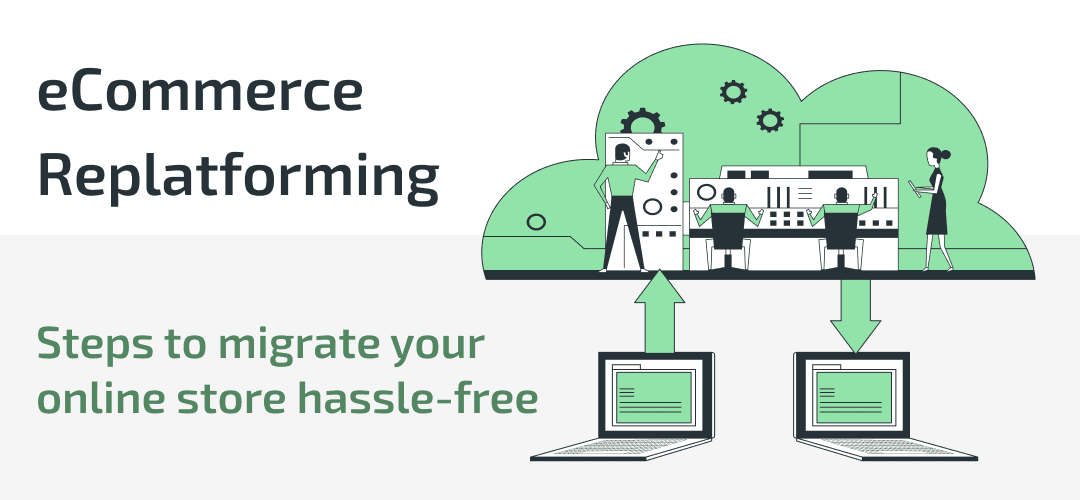
Today's market is more competitive than ever before, and eCommerce retailers must stay up with the rapid technological developments. One of possible ways is to switch to a platform that is more flexible and powerful. A little over 18% of the 93 shops surveyed by Digital Commerce 360 said they were considering switching eСommerce systems.
If you're scaling your online store and beginning to experience noticeable increases in traffic and sales, you'll need a backend system to maintain your website and meet the goals set. The website uptime, user experience, scalability, and capacity for quick adjustments will be directly impacted by the choice of an eCommerce platform. However, replatforming an eCommerce site is a big task. It is a great chance to make some important changes, but the work can be very difficult if you don't know where to begin.
In this article, we'll discuss what is eCommerce replatforming, how to understand when to replatform, why it's significant and what checklist to follow, and how it may benefit you before getting into the specifics of how to migrate store data.
What is eCommerce replatforming
eCommerce replatforming involves moving from your current platform to one that is more appropriate for your company needs. The reasons for eCommerce platform migration can range anywhere from – increasing site or operation speed, adding new functions or non-supported features, experimenting with new business models, or adding more layers on top of your customer experience (e.g. localization, personalization, and more).
There are multiple ways business think of replatforming:
- The first approach is to switch from one monolithic platform to another platform that offers additional plugins and features. In this case, replatforming can be accompanied by redesign.
- The second (modular) approach is to divide platform transition into several stages to prevent upfront costs. For example, if the main problem is an outdated CMS, it is the first component to adjust and then to decide what other elements should be updated within the existing tech stack.
- The third (plug-and-play) approach is to migrate from a monolithic platform to microservices which are discrete applications with different functionalities. This approach essentially refers to headless commerce.
These three types of replatforming have countless variations. To ensure that you fulfill all of your migration requirements and commercial objectives, each project (website) is unique and requires a special strategy. But first of all, you should make sure that you can't do without replatforming. Below you'll find typical "red flags" that means your eCommerce platform calls for more than a planned update.
When it's time to migrate and what things to consider
If you see some of the following issues in your current website, we strongly recommend you to consider eCommerce site migration.
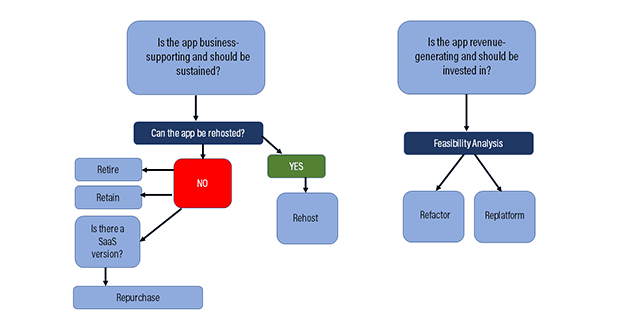
Financial problems
- High maintenance costs. It could be time to switch if maintaining your existing platform is a constant burden. Maintenance also takes time (and much money) and might divert focus from other corporate processes.
- Major costs of ownership. To increase the functionality of your store, you need to add more plugins, make security patches and fix UI issues with the help of professional developers. eCommerce migration can decrease infrastructure or design costs by shifting the burden to a platform provider with a greater level of performance.
Technical problems
- Poor performance. The platform can have difficulties maintaining a large number of physical SKUs for your catalog database or lack an omnichannel support.These restrictions cannot be always overcome with a simple update or upgrade.
- Slow speed and no mobile optimization. An outdated website can become unstable during peak traffic conditions, which causes a poor loading time, high bounce rates and loss of customers. Let alone that 53% of the total web visits are currently mobile, eCommerce replatforming will make your website run more quickly, have a richer user interface.
- Limited scalability. Your current platform might only be able to store a particular amount of attributes, a certain number of product-related assets, a given number of API calls per second, or even lack the support of some content types, for example, video. An online store can be scaled with personalized features like tailored customer content, personalized pricing, product selections, credit limit, order history, and personalized payment options for each customer segment.
Marketing problems
- Streamlined analytics. To gain important insights and improve your eCommerce site, proper analytics is required. A new platform should allow data collection and measurement so you can provide the greatest customer experience.
- Lack of social media capabilities. Integration with social network accounts is one of the most crucial services your platform can offer. This allows users to buy products from brands without leaving the social media app.
- Poor customer experience. If too many plugins slow down your website or if your present platform doesn't offer the most recent technological capabilities, creating the best user experience should be a top concern.
eCommerce migration is typically a laborious, time-consuming and resource-intensive process (be it financial costs or human resources). So it's better to consider the following factors before switching to another eCommerce platform.
1. Desired result of replatforming
Most businesses think about replatforming when they have multiple problems that need to be resolved simultaneously, or when they are scaling, adding new payment options or language versions. Whatever the cause, switching eCommerce platforms won't be worth it if it doesn't increase the output in terms of performance, functionality, design, and overall quality.
Therefore, before you begin the process, you should understand the business objectives that replatforming should satisfy and whether the chosen solution can match your expectations.
2. Time and resources needed
Replatforming is a significant organizational change that takes time and effort to complete. To cut down on time, it is important to keep the team that has already been involved in the migration and has the skills required to move it forward. You should also choose the best time to migrate to a new platform, which is typically when there is little traffic.
Keep in mind that replatforming is a long-term investment and not a quick fix. The solution you intend to use should be flexible enough to move with the market while also responding to your company's needs as it expands.
3. Seamless and easy integrations
Your current eCommerce system is likely integrated with extensions, plugins, and programs that assist with fundamental operations like marketing, sales, CRM, and subscription billing. Not to worry about reducing performance and spending too much time on development to get everything together, make sure the platform you chose integrates effortlessly into your current infrastructure.
The customer shopping experience is influenced by the functionality of your eCommerce store. The more features your website has, the more likely you will enhance conversion rates and boost consumer loyalty.
10 steps to successful eCommerce replatforming
As you can see, replatforming is more significant than merely switching platforms to improve performance. After migrating to a new platform, many eCommerce companies saw a big rise in conversion rates and income. That's why you need to develop a full-fledged eCommerce migration strategy and follow 10 simple steps to complete the task.
Step 1. Determine what features, customizations and integrations you need
List the flaws in your existing platform and determine your most pressing needs, the biggest gaps, and what you plan to gain from the website replatforming. These include automatable processes, information to be moved (i.e. products, existing customers, orders, etc.), resources to facilitate the migration, and the best time to begin and finish the process.
In addition, you should do a realistic assessment, taking into account the overall expenditures, the labor needed to finish the job, and any upcoming deadlines. You want to be aware of both the advantages and any potential drawbacks of replatforming.
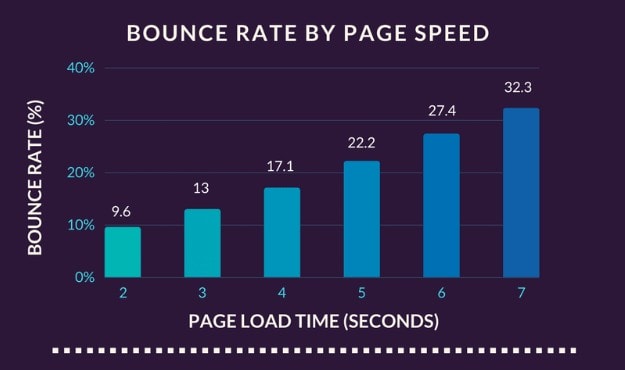
Step 2. Choose a new platform according to your requirements
Make a shortlist of potential eCommerce platforms and arrange them according to features, pricing, and other factors. To compare the tools you are evaluating, it is better to use a table or spreadsheet.
Although you can check several listicles, it's always better to get your hands on the real demo and try each platform yourself. This way you can discover more about the benefits and drawbacks of each option. After testing the demo, you should know more about how the system works, how simple it is to use, and how well it performs.
During replatforming you often need to redesign your website's front-end, which is a great time to go headless. After all, you wouldn't have thought of switching your tech stack if your system could have provided the best shopping experience. And it's always better to do all the major changes at one go than implementing them step-by-step and risking your website being out of operation for too long.
If you currently use a monolithic commerce platform, you're recommended to replatform to a solution that supports headless commerce to make sure you can keep up with the demands of modern online retail. Check out our list of the best headless eCommerce platforms and decide whose features will bring your online business to a new level.
Step 3. Plan your eCommerce replatforming process
A strong pre-migration plan is crucial if you want to minimize customer inconvenience and website downtime. The next step is to create a reasonable task scope and migration schedule. You should draw out all milestones and resources needed at each stage.
Most migration processes will require you to plan tasks in order to tackle the following:
- Creating a new site hierarchy
- Auditing and migrating content
- Front-end design
- Back-end development
- Pre- and post-launch training
- SEO optimization
- Data migration through a third-party service, API plugin, app, or manual CSV transfer.
Step 4. Backup your old eCommerce data
Make sure to backup everything, even if you have a clear plan for your data transfer. It can be challenging to move big volumes of data from one location to another, and mistakes can happen. If it seems implausible, the last thing you want when switching eCommerce platforms is to experience a significant problem while migrating your data.
To avoid being caught in an uncomfortable scenario later on, back up everything to the cloud or an external hard drive. Basically, there are two approaches: manual export or automated backup using a special app. The valuable information you might want to keep includes: website code, database, images, PDFs, and videos, settings and configurations, designs, layouts, and themes, etc.
Step 5. Customize the checkout experience
Depending on the eСommerce platform you use, you may also be able to personalize and improve checkout (to process payments and complete orders). Connect any third-party applications to your new system and make every effort to improve the user flow. The main task is to ensure your consumers have a quick, secure, and effective new experience. The system should recognize, prevent and protect against fraudulent activity.
If you choose a headless eCommerce platform, you can easily integrate checkout functionality from third-party eCommerce migration services. As a result, if you need some specific customizations to handle your checkout process, you can discuss this with your vendor and either work together to develop a solution or add functionality from another provider.
Step 6. Optimize your website for search engines
Another concern is search engine optimization that is likely to take a hit when switching platforms. In the worst-case scenario, the domain authority and the other efforts made by the marketing team to increase traffic to your website may be lost during the migration.
To level an impact on your search rankings, you'll need to conduct a thorough SEO analysis, redirect all of the pages and optimize off-page content.
To mitigate such risks, make sure that you:
- Examine your current content and get rid of any outdated or duplicate material
- Make a thorough redirect scheme that matches pages one-to-one
- Optimize new material for your targeted keywords
- Delete your old site's metadata and schema markups
- Keep an eye on your organic traffic, search positioning, and technical SEO profile.
- Watch out for things like 404 errors, slow loading times, and any other warnings that can point to poor performance.
Anyway, prior to the start of a new campaign or during a busy time for your company, we advise against replatforming since this may have an adverse effect on sales and operational bandwidth.
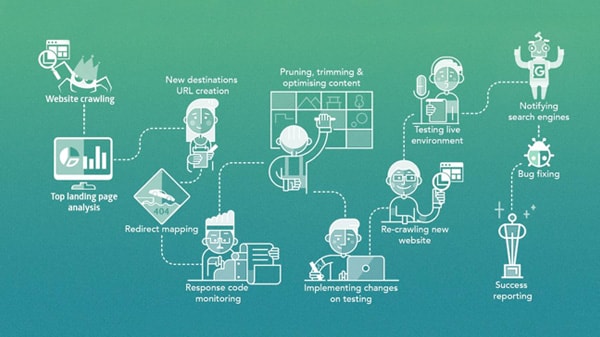
Step 7. Migrate your old store's data
eСommerce data migration is one of the biggest challenges when it comes to replatforming regardless of the method you choose: manually, through a migration app or a third-party team. Some of your data (especially customer, category and product data) could be lost permanently. Make sure you understand where your data is stored, whether you will have access to it during the transfer, and where it will be located on the new platform.
Whichever option you go for, the pre-migration data plan will help you avoid costly pitfalls and possible data losses:
- Incorrectly mapped products
- Incorrectly displayed prices
- Limited personalization due to poorly synced customer data
- Negative impact on customer experience due to an improperly functioning website.
Step 8. Restructure and redesign your webshop
Most time and resources will probably be spent during the design and development phase. That's when your designers and developers will build the front and back ends of your new eCommerce website.
It's also a good time to make important adjustments to your website's navigation, content, user experience, design, or back-end operations, adapting them to a larger scale or completely changing their functioning. In the end, all of the data you back-upped and transferred over is placed into your newly redesigned website.
Step 9. Test the site changes made
Run numerous tests before launching your new website to ensure that you can add items to your shopping cart, complete a transaction, and use custom features to make sure everything works as it should. It's recommended to test each page, button and form, even though it can seem excessive..
Check that all of your pages are loading and functioning as intended by running your site through a performance auditing tool like Google PageSpeed Insights. By doing this, you can be sure that your website won't experience any speed or usability troubles.
Ask internal stakeholders to work on the website's back end and fulfill particular tasks. Think about offering some of your most devoted clients beta or early access. Collect all of this feedback, and make the necessary adjustments before launch.
Step 10. Launch your new eCommerce website
Relaunching at a period of low traffic, such as early in the morning, could help you minimize any potential inconvenience. To give your users a better experience, you need to monitor analytics and constantly enhance your eCommerce website.
Once your new site is live, keep checking for errors. It's not always a guarantee that doing everything perfectly in a test environment will protect you from mistakes in the real world. You shouldn't expect all the steps to go according to a plan. But if your team stays on top of any problems, you can minimize things like 404 errors and page misdirects.
eСommerce replatforming checklist
- Check your current ecommerce platform and audit all issues
- Define your business needs, long-term goals and platform requirements
- Decide what legacy information should be migrated
- Select the best time for migration (off-season, low-traffic, etc.)
- Consider the best platform options for your business
- Forecast your revenue and total cost of ownership
- Distinguish between built-in functionality and third-party apps
- Form a pre-migration website plan
- Migrate your data and content
- Create new website content
- Build website navigation and hierarchy
- Design front- and back-end (including mobile responsiveness)
- Conduct SEO and map URL redirects
- Relaunch in beta and QA with stakeholders
- Test before and after eCommerce replatforming
- Train personnel to help them use the new platform and its components
- Make your new website public
- Monitor traffic and search rankings
Successful eCommerce migration examples (and tools to do the task)
To actually start migration, you need a new eCommerce platform meeting your requirements and capable of storing your current data. When evaluating candidates, we recommend keeping the following key factors in mind:
Ease of use: You should learn beforehand how much time and effort you and your team will spend to master the new platform.This criteria will determine the scope and overall cost of replatforming.
Functionality: Make sure the chosen platform has the features and tools you need to run your business effectively. The implemented time and smooth transition are also significant factors to consider.
Security: The platform must protect confidential information using PCI DSS compliance, fraud detection and data encryption. It's better to opt for a solution that offers such features out-of-the-box.
Support: In case you need professional support, make sure you'll get the necessary assistance 24/7.
Pricing: The overall pricing and cost of ownership can be trickier to calculate. To understand whether a particular platform fits within your budget, learn more about its maintenance and any other hidden costs (e.g. outsourcing expertise, consultants, monthly fees).
Considering these factors, nopCommerce is a perfect candidate for migration from your current eCommerce solution. It offers rich functionality, pluggable architecture, and compatibility with third-party apps and integrations – all these give you enough flexibility to create a personalized eCommerce experience for your customers.
In addition, B2B eCommerce replatforming to nopCommerce is smooth and efficient, with no need to compromise any quality or functionality. This platform is made for scalability, so you can easily add new features and functions as your business grows.
And don't take our words for granted. To see for yourself that nopCommerce can help you solve the critical issues and further develop business activity, take a look at a few eCommerce replatforming examples below.
Store migration and redesign for electronics retailer
Zoomer is one of the biggest electronics retail chains in Georgia. Their online store had been using CS-Cart for about 8 years before switching to nopCommerce. Due to the vendor's absence from the local market and ineffective communication, maintenance was slow and difficult to manage.
One of the main difficulties was integration with the accounting system. The website data updates also required a lot of work. The design was outdated, adding features and supporting basic modules was almost impossible. In response to these issues, the business decided to replatform their website.
As part of replatforming, the following changes were made:
- A fresh, appealing and mobile-friendly design was developed
- The home page now includes all search results under "Browsing History"
- Custom filters for the menu were added to only see the filter characteristics that are compatible with the chosen brand
- The new methods of payment were developed since online installment loans are very popular in Georgia
- More than 30k products have been transferred from the previous version of the website.
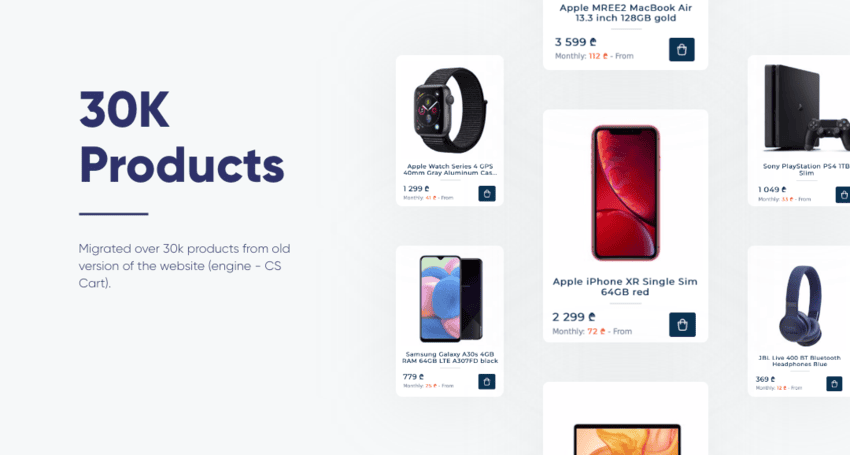
As a result, the renewed website got a seamless integration with its price management system and customer-oriented design. 80,000 users visit the marketplace per week and an average session duration has increased to 4 minutes.
Website migration from nopCommerce 4.30 to 4.40
Doors Direct is a popular online retailer for wooden windows and doors in South Africa. The company needed to upgrade their website to nopCommerce 4.40 while also making some changes to their custom solutions.
In the process, the development team faced a number of challenges: the identification of all customizations, migration of the existing features, the implementation of new features, and lack of access to parts of the customized source code.
While working on the new website, the team did the following:
- Developed a functional UX to enhance the website style, brand identity, and user experience
- Realized a more practical address selection and quote request to increase accessibility and functionality
- Showcased products to potential clients and directed them to physical stores
- Increased the number of new users by 10%.

Final takeaways
Even if there are numerous reasons to be concerned about eCommerce replatforming, let's focus on the positive sides and what to expect when migration is done well.
With replatforming, your product, category and customer data is better organized, which enables more data-driven product development, gives cross and upsell opportunities, and even creates a more personalized shopping experience for your customers.
A modern eCommerce solution will help your visitors enjoy faster load times and a custom checkout process tailored to their language, currency, and preferences. Going headless with replatforming also gives you access to other options for site performance and functionality (integrate new features and new services fairly quickly and easily) you wouldn't have with a monolithic platform.
So as you can see, with a proper replatforming plan and a detailed roadmap, eCommerce migration doesn't have to be a huge burden.